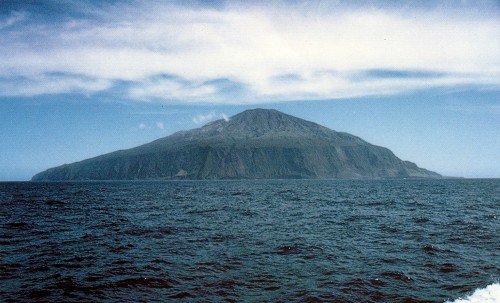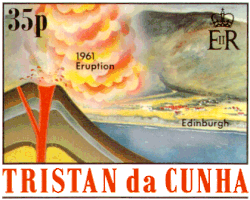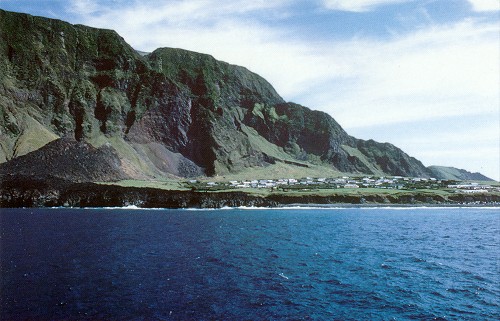
 Tristan da Cunha (37.08°S, 12.28°W) is even more remote than
its sister islands of St. Helena and Ascension. Tristan lies 1,900 km SSW of St. Helena and 2,400
km from Cape Town. The island is almost circular with an area of 98 sq. km, rises to a central
peak of just over 2,000 m, and is surrounded by sheer 300- to 600-m-high cliffs
(topographic map). The only habitable part of Tristan is a
small plateau at the foot of the cliffs on the northwest side of the island. Tristan lies in the
Roaring Forties, and the weather is liable to sudden drastic changes, and is often violent.
Tristan da Cunha (37.08°S, 12.28°W) is even more remote than
its sister islands of St. Helena and Ascension. Tristan lies 1,900 km SSW of St. Helena and 2,400
km from Cape Town. The island is almost circular with an area of 98 sq. km, rises to a central
peak of just over 2,000 m, and is surrounded by sheer 300- to 600-m-high cliffs
(topographic map). The only habitable part of Tristan is a
small plateau at the foot of the cliffs on the northwest side of the island. Tristan lies in the
Roaring Forties, and the weather is liable to sudden drastic changes, and is often violent.
There are five islands in the Tristan group; Tristan itself, and the smaller uninhabited islands of Nightingale, Inaccessible, Middle, and Stoltenhoff. Tristan, like St. Helena and Ascension, is volcanic in origin, as illustrated by the eruption in 1961.
History
 Tristan was discovered by the Portuguese in 1506, and is named after it's discoverer,
Tristao da Cunha. Tristan was seldom visited during the following centuries, but, as with
Ascension, it became strategically important with the exile of Napoleon to St. Helena and the
British formally annexed Tristan in August 1816. A small garrison was established on the island,
and when it was withdrawn in 1817 one of the soldiers, William Glass, elected to remain on
Tristan with his family. Over the following 75 years a number of settlers and shipwreck survivors
joined Glass, but only a few stayed the course, adding the surnames Green (Dutch), Swain
(English), Hagan (American), Rogers (American), and Repetto and Lavarello (Italian). An eighth
surname, Patterson, was added only recently when an Englishman married to a Tristanian returned
to settle on Tristan.
Tristan was discovered by the Portuguese in 1506, and is named after it's discoverer,
Tristao da Cunha. Tristan was seldom visited during the following centuries, but, as with
Ascension, it became strategically important with the exile of Napoleon to St. Helena and the
British formally annexed Tristan in August 1816. A small garrison was established on the island,
and when it was withdrawn in 1817 one of the soldiers, William Glass, elected to remain on
Tristan with his family. Over the following 75 years a number of settlers and shipwreck survivors
joined Glass, but only a few stayed the course, adding the surnames Green (Dutch), Swain
(English), Hagan (American), Rogers (American), and Repetto and Lavarello (Italian). An eighth
surname, Patterson, was added only recently when an Englishman married to a Tristanian returned
to settle on Tristan.
The most significant event in Tristan's recent history was the 1961 volcanic eruption and the resulting evacuation of the entire population to the UK. The eruption was of modest size, but occurred from a small cone immediately adjacent to the settlement of Edinburgh. After two years in England almost all of the 264 evacuated Tristanians elected to return to their island.

The settlement of Edinburgh with the 1961 volcanic cone to the left.
Present Day Tristan
The present population of Tristan is about 300 and modern Tristan boasts a school, a hospital, a post office, a village hall, a museum, a craft shop, a cafe, a pub, and a swimming pool. After the eruption a new crayfish (rock lobster) canning factory was built (the old one was engulfed in lava). The income derived from fishing and the sale of postage stamps makes the island financially self-supporting.
The Tristanians still make and use their renowned long boats.
The RMS St. Helena calls at Tristan only once each year, on its January/February voyage. The RMS stays at Tristan for only 2-3 days, and passengers get ashore only if the weather is obliging. The only other means of reaching Tristan is on fishing boats out of Cape Town.
![]()
Tristan da Cunha Bibliography (arranged by year of publication)
To obtain in- and out-of-print books inquire at Miles Apart.
Additional literature sources are in Day's exhaustive bibliography.
- Carmichael, D. Some account of the Island of Tristan da Cunha, and of its
natural productions. Taylor, London. 1818.
- Earle, A. A narrative
of a nine months residence in New Zealand in 1827; together with a journal of a residence in
Tristan D'Acunha, an island situated between South America and the Cape of Good Hope.
Longman, Rees, Orme, Brown, Green & Longman, London. 1832.
- Barrow, K.M. Three years in Tristan da Cunha. Skeffington & Sons, London. 1910.
- Rogers, R.A. The lonely island. Allen & Unwin, London. 1926.
- Gane, D.M. Tristan da Cunha; an empire outpost and its keepers, with glimpses
of its past and consideration of the future. Allen & Unwin, London. 1932.
- Christopherson, E. Tristan da Cunha, the lonely isle. Cassell, London. 1940.
- Brander, J. Tristan da Cunha, 1506-1902. Allen & Unwin, London. 1940.
- Crawford, A.B. I went to Tristan. Hodder & Stoughton, London. 1941.
- Booy, D.M. Rock of exile; a narrative of Tristan da Cunha. Dent,
London. 1957.
- Holdgate, M. Mountains in the sea. Macmillan, London. 1958.
- Mackay, M.M. Angry island: The story of Tristan da Cunha (1506-1963).
Barker, London. 1963.
- Hosegood, N. The Glass island, the story of Tristan da Cunha. Hodder
& Stoughton, London. 1964.
- Falk-Ronne, A. Back to Tristan. Allen & Unwin, London. 1967.
- Munch, P.A. The song tradition of Tristan da Cunha. Indiana University
Research Center for the Language Sciences, Bloomington. 1970.
- Munch, P.A. Crisis in utopia; the ordeal of Tristan da Cunha. Cromwell,
New York. 1971. ISBN: 0690220758
- Cross, A. St. Helena. David & Charles, Newton Abbott. 1980. ISBN: 0715380753
Has some information about Tristan in a short appendix entry.
- Crawford, A. Tristan da Cunha and the Roaring Forties. Skilton, Edinburgh. 1982. ISBN: 0284985899
- Winchester, S. Outposts. Hodder & Stoughton, London. 1985. ISBN: 0340337729
(Published in the US as The Sun Never Sets, Prentice Hall, New York. ISBN: 0138758816)
Has a chapter about Tristan.
- Bain, K. St. Helena: The Island, Her People and Their Ship. Wilton 65, York. 1993. ISBN: 0947828176
Has a chapter about Tristan describing a two-day visit.
- Ritchie, H. The Last Pink Bits. Hodder and Stoughton, London. 1997. ISBN: 034066682X
Has a chapter describing a five-hour visit to Tristan.
- Day, A.E. St. Helena, Ascension and Tristan da Cunha. Clio Press, Oxford. 1997. ISBN: 1851092722
World Bibliographical Series, volume 107.
Available as an eBook at netLibrary, but requires payment of an annual fee to view the eBook.
![]()
National Geographic Articles
- Foran, W.R. Tristan da Cunha, Isles of Contentment. National
Geographic, vol. 74, p. 671-694. 1938.
- Lewis, L. New Life for the "Loneliest Isle". National Geographic, vol. 97,
p. 105-116. 1950.
- Wheeler, P.J.F. Death of an Island, Tristan da Cunha. National
Geographic, vol. 121, p. 678-695. 1962.
- Blair, J.P. Return to Lonely Tristan da Cunha. National Geographic, vol.
125, p. 60-81. 1964.
![]()
 Visit Saint Helena
Visit Saint Helena
Photographs of Tristan da Cunha are courtesy of Noe Zamel (noe@io.org)
Comments? Corrections? More information? Contact:
Barry Weaver, Geology and Geophysics, University of Oklahoma - bweaver@ou.edu
Page maintained by Barry Weaver
Last updated:
15 December, 2011
